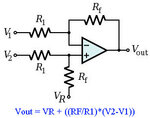Sumihere
Newbie level 5
Hi Friends,
I need to implement bipolar 10-bit ADC using PIC18F4520.
Wherein, Vref+ = +5V & Vref- = -5V.
The input varies from -5V to +5V.
I implemented the same in Proteus VSM Simulator. (ADCON1 = 0011 0000 )
The results obtained are : -5V ----> 000 (Hex)
+5V----> 3FF (Hex) [1023 - Decimal ]
I wanted to know if it is okay to give a negative voltage to Vref- & the analog input channel..???
Will it damage the PIC..???
Looking forward to your reply.
Thanks in advance
I need to implement bipolar 10-bit ADC using PIC18F4520.
Wherein, Vref+ = +5V & Vref- = -5V.
The input varies from -5V to +5V.
I implemented the same in Proteus VSM Simulator. (ADCON1 = 0011 0000 )
The results obtained are : -5V ----> 000 (Hex)
+5V----> 3FF (Hex) [1023 - Decimal ]
I wanted to know if it is okay to give a negative voltage to Vref- & the analog input channel..???
Will it damage the PIC..???
Looking forward to your reply.
Thanks in advance
